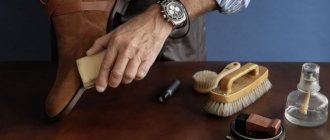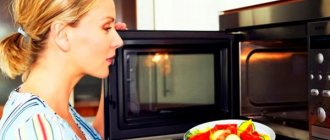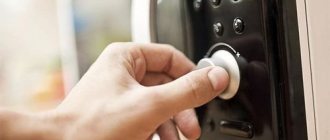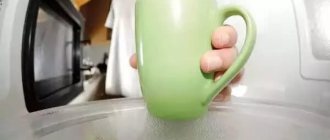In early models of microwave ovens, a sticker with a ban on boiling water was placed in a visible place. The labels on modern ovens say that this is possible by placing a small object, such as a wooden spoon, in the dish. Since each model has its own characteristics, it is impossible to create a single instruction on how to boil water in a microwave.
To the question: is it possible to boil water in a microwave oven, the answer should be - it is possible, but too dangerous. But if for some reason you have to do this, then in order to avoid burns and other troubles, you should follow safety measures.
Do not try to place tea bags in a bowl of water before boiling. They contain metal clips that can cause an electric arc with dire consequences. If someone claims that they boil it along with the bags, it means they came across a package without staples or are just lucky.
What is the danger
You don’t need to be a physicist or delve deeply into the specifics of heating various liquids in a microwave oven. Before moving directly to the question of how to boil water in the microwave, let's talk about the dangers of this process. Unlike heating on a stove, this often happens without the formation of bubbles. We, by analogy with heating on a stove, stubbornly wait until the liquid begins to gurgle.
Food
HayDmitriy / Depositphotos
- Vegetables that need to be boiled or steamed. New York Times food writer Mark Bitten suggests putting vegetables in a bowl with a little water and experimenting. For example, he cooks asparagus himself for 2 minutes, cauliflower - 5 minutes, eggplant - 5-7 minutes, spinach - 1-2 minutes. Potatoes, carrots and beets need a little more time - about 7, 10 and 15 minutes respectively.
- Peeled boiled eggs. If you want to reheat them, cut them into pieces to prevent them from exploding.
- Citrus. To make it easier to squeeze the juice out of a lemon, orange or grapefruit, cut the fruit in half and microwave for 20–30 seconds.
- Popcorn. It's much easier to cook in the microwave than on the stove - just follow the instructions on the package.
- Bread and pastries. They will become softer and tastier. This way you can even “revive” stale bread.
It is forbidden
annabieniek / Depositphotos
- Grape. Raisins will not work this way: in a microwave oven, the berries ignite and form plasma.
- Hot pepper (dried or dishes with it). The substance capsaicin, which makes the vegetable hot, will evaporate when heated. If you inhale these fumes, you can get a strong burning sensation in your eyes and throat, almost like being hit with pepper spray.
- Raw and boiled eggs in shell. They will explode when heated in the microwave. Scientists explain this by saying that the yolk heats up much faster than the white, which leads to an explosion. Moreover, this can happen even if you pierce a boiled egg with a fork.
We suggest you read why the washing machine does not heat the water when washing, the reasons
Basic Rules
You can actually boil water in the microwave. You just need to follow a number of rules. It is especially important to tell children about them, since most often they get burns due to improper handling of a microwave oven.
- Do not place a vessel with water in the microwave oven for more than 2 minutes.
- When you hear the signal, do not immediately take out the glass. Wait 30 seconds.
- Fill the vessel no more than halfway with water.
- Pay attention to the material of the vessel. If the mug contains metal inserts, then it is not suitable for microwave ovens.
- Place a wooden spoon in a cup or other shallow dish.
General Tips
It is useful to familiarize yourself with general tips before you start boiling water using the chosen method. So, pay attention to these recommendations:
- Both steam and boiling water are very hot. Be careful with any utensils or appliances used to boil liquids. It is rational to use a potholder.
- Remember that it is not advisable to boil distilled water in a microwave oven, as it may overheat due to the lack of impurities that provide steam formation.
- Know that steam is much hotter than boiling water, so if you burn yourself with it, it will lead to more serious consequences.
- It is advisable to boil drinking water before drinking to get rid of bacteria and germs.
- Cold water drawn from the tap is cleaner than hot water.
There are many ways to boil water at home or camping. This article describes the main and most common of them. All you have to do is choose the one that suits you and start boiling the liquid.
Selection of cookware
If you do it incorrectly, you can lose both the dishes and the microwave oven. Therefore, before boiling water in the microwave in a mug, you need to carefully inspect the vessel. Glass or ceramic glasses are suitable for microwave ovens. Plastic and foam are used only if they are approved for use in the microwave. This is indicated by special symbols that are printed on the product.
Why can't you use dishes made from other materials? Because this can lead to unpleasant consequences:
- Uneven heating.
- Cracking of the walls of the dishes.
- Margarine or yogurt cups will melt and catch fire.
- Metal utensils interfere with the operation of the oven.
- If you place a closed container in the oven, the steam pressure may rupture it. Spilled boiling water will ruin the oven.
Steps
How to choose the right cookware
To boil water in the microwave, the first thing you need to do is choose the right utensils.
Check the table below to see if your cookware is suitable for this.[2] X Source of information Which dishes are suitable for use in the microwave oven
| Material | Safely? | Note |
| Glass | Yes | |
| Ceramics | Yes | |
| Paper plates | Yes | |
| Wax/parchment paper | Yes | |
| Most metals (including aluminum foil and silverware) | No | When heated in a microwave oven, metals may begin to spark, which may damage the microwave oven or even cause a fire. [3] X Source of information |
| Brown paper bags | No | May cause fire and/or toxic fumes.[4] X Source of information |
| Sealed/airtight containers | No | May explode under pressure from hot steam. |
| Disposable containers (packaging of yogurt, margarine, etc.) | No | May melt, ignite and/or release toxic fumes. |
| Plastic (packaging, food containers, etc.) | Usually no | There is some (disputed) evidence that harmful chemicals found in plastic can leach into food when microwaved. However, plastic utensils approved by the relevant regulatory authority can be used. |
| Styrofoam | Usually no | See item "Plastic"; Some Styrofoam utensils labeled "microwave safe" can be used safely. |
How to heat water safely
- 1Pour water into a special container.
Boiling water in the microwave is incredibly easy (even for the super-safety-conscious). First, pour water into a suitable container (see table above).- Make sure the container is not covered with a lid. Hot steam can cause a dangerous explosion.
- 2
Place a suitable container of water in the microwave.
Next, place a non-metallic object, such as a wooden spoon or chopstick, into the container. This will prevent the water from overheating, causing bubbles to form.
- Overheating occurs when the water in the microwave reaches a temperature above the boiling point, but fails to form bubbles due to the lack of a bubble formation site
(mainly uneven areas that force the bubbles). If the water is disturbed in this state, steam will very quickly begin to form, which will lead to an increase in the volume of hot water.[5] X Source of information
If you don't have any non-metallic objects to put in the water, try using a container that has a scratch or chip on the inside. This will serve as a source of bubble formation.
- Overheating occurs when the water in the microwave reaches a temperature above the boiling point, but fails to form bubbles due to the lack of a bubble formation site
- 3
Place the water in the microwave.
Heat it in short intervals (no more than a minute and a half), stirring regularly until the water releases steam. Even if you diligently follow all these steps, you may miss the point of bubbles forming, which is unlikely when boiling water on the stove. The most reliable way to find out if water is boiling is to use a thermometer. At sea level, water boils at 100°C; The higher sea level you are, the lower the boiling point.
- If you are using a dish that retains heat well (such as glass or ceramic), be careful when removing it from the microwave. Use a towel or oven mitts to avoid getting burned.
- 4
If you are sterilizing water, continue to boil it for some time.
If you boil water to purify it, microwave it long enough to ensure that any microorganisms in it are killed. The recommended boiling time for water before the safety threshold is reached is one minute, or three minutes at an altitude of 2,000 meters above sea level.
[6] X Source of information
How to avoid the threat of overheating (tips)
- 1Don't heat the water for too long.
Perhaps after reading the tips above, you are worried about the threat of overheating. Don't worry, though—there are many other simple precautions you can take. Probably the most effective way to avoid overheating water isdon't heat it up for too long
. If the water has not yet reached its boiling point, it cannot be overheated.
- The exact amount of time you should follow when microwaving water may vary depending on the wattage of your microwave. To be safe, try to limit the heating time to one minute at the very beginning. Depending on how much the water heats up in that first minute, adjust the time of your next round accordingly.
- 2
Try not to use cookware that is too smooth.
For the same reason that we recommend adding something non-metallic to the water or using a container with scratches, we do not recommend using perfectly smooth containers. Examples of such unwanted cookware include new glass and ceramic bowls, although there are many other materials that pose a potential problem.
- Instead, use older, more worn-out cookware or cookware with visible scratches on the bottom; Such dishes will provide the necessary conditions for the formation of bubbles.
- 3
Gently tap the container of water when it has finished heating.
Once you are sure that enough time has passed for the water to warm up, check to see if it is overheated by hitting the container before removing it from the microwave. Ideally, to protect your hands, this should be done using
long tool
.
- If the water is overheated, hitting the container may cause water to overflow. Water may spill in the microwave, but this will protect your hands from possible burns.
- 4
Stir the hot water with a long object while it is still in the microwave.
Still not sure that the water is not overheated? Stir it using, for example, a kitchen spatula to be sure. When an object touches water, it will allow bubbles to form on its surface; If the water is overheated, it will begin to quickly increase in volume and may overflow. If not, congratulations! You are safe.
- 5
Do not put your face too close to the hot water container until you are sure it is safe to do so.
You may think this isn't worth mentioning, but
it's important to keep your face away from the water if there's even a minimal risk of overheating
. Most injuries occur when a person removes water from a microwave oven and looks into the water container; A sudden increase in water volume can lead to serious burns to the face and even permanent loss of vision in the worst case scenario.
What happens when it overheats
Children rarely think about how to boil water for tea in the microwave. After placing the glass in the oven, they wait until bubbles appear. In this case, heating occurs faster than bubbles form. This is especially true for new dishes, where there are no cracks in which they form. And if the gas does not come out, then heat is not released. You have a time bomb. When you remove the cup, the slight vibration from shaking will be enough to cause bubbles to form. And the boiling water will splash out, just as it happens with sparkling water.
It's very sad, but most people are unaware of this danger. Therefore, they receive 1st and 2nd degree burns and even lose their vision. And most often these are children for whom it is easier to boil a glass of water this way.
More about the study
For many years, people have been doing something completely wrong that seems simple at first glance – brewing tea. The habitual pouring of boiling water over dry leaves or a bag does not allow you to enrich the drink with the maximum amount of useful substances.
Green tea
It is known that some types of tea, such as green and red, must be brewed with water, the temperature of which should not reach 100 degrees. Overboiling water spoils and makes the drink hard and almost tasteless. Moreover, a drink made from water that has been boiled again several times can be harmful to humans.
A cup of tea
Using this information, eminent scientists decided to find a more acceptable and faster way to prepare the most popular drink among the planet's population. They proved that brewing tea in the microwave is quick, tasty and at the same time healthy. This method helps the tea leaves release antioxidants, amino acids and caffeine.
Brewing tea from a kettle
What to do
Is it possible to boil water in the microwave? Yes, of course, but if one of your relatives uses this method to quickly get boiling water, then you need to protect him as much as possible. Buy a water thermometer. You need to attach it to the mug and watch the indicators through the glass. Once the temperature reaches 100 degrees, it's time to turn it off.
You must wait 30 seconds before removing the mug. After this, open the chamber and stir the liquid with a wooden spoon or stick. If the water does not start to overflow, then everything is in order. Have a comfortable oven mitt or towel ready next to the stove. Even if the mug is taken out in time, it can be quite hot. It is easy to get burned and drop it, resulting in serious burns to your feet.
Let's find out: how long does it take for water to boil?
The boiling speed directly depends on the following factors:
- the type of container it is poured into;
- the place where it boils;
- diameter of the heating source;
- heating temperature;
- quantity (the more, the longer it will take to boil);
- isolation of the container (in a container covered with a lid, the process is accelerated);
- the size of the cookware (the larger its diameter, the less time it will take to boil);
- the initial temperature of the water medium itself (already heated or warm will boil faster than cold);
- adding substances to water that reduce heat loss (vegetable oil).
the rate of boiling . If it is low, then the boiling process begins when the water reaches a temperature of less than 1000C. As the pressure increases, the boiling time increases
Reference. . The aqueous medium will not begin to boil at a temperature of 1000C. This will require a higher temperature.
How long does it take to boil in a kettle and saucepan?
In the two types of containers indicated, water boils after different times. It boils much faster in a kettle. This is especially true for an electric kettle.
It takes 3 minutes to boil a liter of water in it. A kettle on a gas stove boils in 7-10 minutes. It takes the longest time for water to start bubbling in a kettle heated on an electric stove. This takes about 10-15 minutes.
It takes varying amounts of time for water to boil . The type of stove used plays a role.
For boiling to begin in a pan heated on a gas stove, on average you need to wait 6-7 minutes.
On an electric stove, boiling begins in the pan after 8-10 minutes. On modern induction electric stoves, water in a pan boils very quickly. It takes 3-4 minutes to boil a liter.
Important . The more you pour into the kettle or pan, the longer it takes to boil.
How does time change depending on where you cook?
How quickly the liquid begins to boil depends on the place of preparation . There are different times for the start of boiling in a container placed in a microwave and water cooking over a fire. Also, different times for the start of boiling are observed when boiling on a gas and electric stove.
In the microwave
But as soon as you take out a cup of water and put any object into it, it will begin to boil violently.
To bring water to this state, just hold the glass with it in the microwave turned on at full power for 2 minutes.
On a gas and electric stove
In a container placed on gas, boiling begins faster than in a container placed on an electric stove.
When cooking with gas, the container comes into direct contact with the fire.
Moreover, the area of its contact with the pan or kettle is large if the fire on the gas stove is turned on to maximum.
The water will boil within 6 minutes. Half a liter boils in just 3 minutes 15 seconds.
When cooking on an electric stove, the time increases. This is due to the fact that the container itself does not come into contact with open fire. It is heated by a heating element through which an electric current passes.
All this increases the heating process. Half a liter will boil on the electric stove in only 5 minutes. It takes 8-10 minutes to boil a liter.
On fire
The boiling time for water over an open fire is the longest. Conditions play a role. If it is windy outside, the container will take longer to warm up. Boiling may take longer.
The container in which the water is boiled plays a role . If it has thick walls, then it will take much longer to boil in it over an open fire. The thinner the walls of the container, the faster the boiling process will begin. On average, boiling begins in 10-15 minutes over a fire.
Is it possible to speed up the process?
The following effective options exist:
- Boiling water in an electric kettle. This device will boil it 2-3 times faster than in any other vessel.
- Covering the container with a lid. It will reduce heat loss.
- Selection of cookware with a wide bottom. The water will be evenly distributed over the entire surface of the container. The area of its heating will become much larger, which will lead to the beginning of its seething.
- Place the pan on the burner with the largest diameter. Due to this, the heating area of the container will increase.
- Adding vegetable oil to water. Even a small amount of it accelerates boiling. Oil forms a film on the water surface. It prevents evaporation. At the same time, the outflow of heat becomes less.
Peculiarity. Salt does not speed up the boiling of water. Its crystals only create the illusion of boiling. This is due to salt getting into uneven and defective areas of the container, which causes bubbles to form. The salt itself only increases the boiling point.
Conclusion
The boiling time of water depends on a number of factors. The main ones are the container in which it is boiled and the place where it is prepared. It boils fastest in an electric kettle.
Also, boiling occurs faster when using an induction cooker. It takes longer to boil if the water is cooked on an electric stove. Boiling takes the longest time over an open fire. The boiling process can be accelerated by covering the container with a lid.
It is also recommended to choose a container with a wide bottom for boiling and use burners or other heating sources with a large diameter.
Trying is not torture
Of course, you can make yourself a glass of tea or coffee this way. Moreover, this will require quite a bit of time. But modern kettles boil literally in a matter of minutes. It's convenient and completely safe. You are guaranteed not to get burned, and the water temperature will be optimal for tea. Of course, it’s easy to assume that the kettle is out of order, but no one canceled the tea.
A microwave may well become a replacement for this unit. Especially if you live alone and only need to make one cup. By following all the recommendations, you will easily get a cup of boiling water and be able to brew yourself aromatic tea. Safety precautions are not empty words. In this case, ignoring the rules can result in serious injury, despite the apparent safety of the microwave oven.
Optimal mode and temperature
Most microwaves do not have a special setting for boiling , so you can use the same setting as for other tasks. Boiling time usually takes no more than a minute, but in less powerful oven models it can take up to three minutes. Therefore, the best way remains to control the temperature using a thermometer placed in a container of water.
About the symbols on microwave cookware
Is it possible to heat food in a plastic container in a microwave?
Which bottles are better?
Only certain types of cookware are suitable for use in the microwave. Experts advise against heating in containers that contain bisphenol, since when heated, the substance is released into food and has a harmful effect when ingested. Such bottles and containers are marked with the symbol “PC”. If you have doubts about the quality of the dishes and the possibility of heating them in the oven, it is better to use ordinary or glass dishes for these purposes.
Many people refuse to use microwaves, citing the fact that microwaves make food tasteless, provoke the growth of cancer cells in the blood, create carcinogens in milk, destroy the functions of the digestive system and, in general, are more like killer machines than a means of cooking.
Let's try not to panic and figure out how justified such conclusions are.
Precautionary measures
- When heating water in the microwave, do not forget to put some dielectric object into it.
- Do not use closed containers to avoid explosion.
- Do not bring boiling water close to your face. An unexpected release of boiling water can lead not only to burns, but also to loss of vision, as happened to a young man who was heating water to drink a cup of hot coffee.
- Wait 0.5 minutes before removing dishes from the chamber. If nothing happens, stir the water with a long stick. If the object overheats, bubbles will condense, and the water will overflow due to the increase in volume. If there is no overflow, then you can safely take out the cup.
- When boiling for the first time, do not set the timer for more than a minute. The length of time it takes for water to boil depends on the amount of water and the power of the stove. Therefore, by the degree of heating of water per minute, you can determine the required time to boil a certain volume. Powerful ovens need 1 minute to bring to a boil; weak ovens will require 3 minutes.
- When using dishes that have the ability to retain heat, in particular ceramic ones, you need to remove them using a potholder or towel.
- Do not try to heat vodka in the microwave, for example for a compress, or other alcohol-containing liquids. Alcohol evaporates quickly even at room temperature, so at best, all that will remain in the oven is steam with the smell of fusel. In the worst case scenario, the vapor will ignite if there is a source of high temperature nearby.
The microwave is, of course, convenient when you need to quickly boil a small amount of water. However, you should not abuse the oven for this purpose, since after clinical trials it turned out that the structure of water changes under the influence of microwave radiation. That is, the body receives low-quality water, which can disrupt metabolism.
Proper nutrition is an important factor for the normal and full development of infants. Modern technologies have made people's lives much easier, and a young mother no longer spends a lot of time heating food or defrosting food, since a microwave oven does this in minutes. At the same time, everything that concerns the health of the child worries her in the first place, so many women during this period are worried about the question of whether it is possible to heat the formula for feeding the child in the microwave.
The answer to the question of whether it is possible to heat baby formula in the microwave is directly contained in the manufacturer's instructions, which are included with baby products. Both on the bottle itself and on the packaging with baby food there is a direct indication that you cannot heat the formula in the bottle in the microwave.
Manufacturers of baby food for babies, in their recommendations for preparing baby formula, say that preparing a large volume of formula is not recommended. If there is leftover food, it should not be used for infants at the next feeding. In connection with this warning, it is necessary to prepare food in such quantities that are sufficient for one feeding.
There are no definitive studies showing the dangers of microwave ovens. The operating principle of the oven is based on the usual transfer of heat from a source to products. In this regard, it is possible to heat water in the usual way using it. To do this, you must follow safety rules and use microwave-safe containers.
Advantages of a microwave oven
In addition to super-speed and enormous versatility, microwave ovens heat food evenly and efficiently, without requiring oil, as is the case when heating food on the stove. Microwaves take up little space and are equipped with a bunch of different additional options, from a spit to a sound warning system.
Many manufacturers equip their stoves with a stylish design, a “child lock” system, books of special recipes, lower and upper grills, a timer and a mind-boggling number of operating modes that know how to make soup, popcorn or even muffins. Don't neglect to read the instructions for your microwave: you will find individual care and safety tips there.
Porcelain, ceramics, glass are the best dishes for heating everything you can in the microwave. You should be more careful with porcelain - there should be no patterns on it, with polyethylene and cling film - they need to be pierced in several places before use, and with plastic - such containers must indicate that they are suitable for the microwave and are made of safe material . By the way, linen or cotton napkins are best suited for heating bread and pastries.
Try using the microwave: for example, heating citrus fruits for 15 seconds to get all the juice out of them, or speed up the soaking of beans by filling them with water and heating them for about 10 minutes.
Never, under any circumstances, try to boil eggs in their shells in the microwave: the explosion will be impressive, and scrubbing the oven and the surfaces closest to it will take a very long time. Metal and objects containing it, such as gold rims on dishes or foil, should also not fall into the microwave oven under any circumstances.
Disposable plastic food containers, plastic bags, and even brown paper bags should be removed from food before heating. Be careful and do not start the microwave empty: this will not only damage the oven itself, but in case of any malfunction you can cause an accidental fire.
A microwave makes life much easier for the modern housewife. At the same time, debates about how safe its use is still ongoing. Therefore, many people decide to use the oven only to heat food and not to cook. Today we’ll talk about how to boil water in the microwave.
How does a microwave oven work?
The more incomprehensible a thing is to us, the more hostility and fear it causes. To some people, microwave ovens seem creepy only because they don’t know anything about the principle of their operation, which, in general, is not that complicated. The heart of any microwave oven is a magnetron - a source of radiation of special high-frequency radio waves (microwaves), which, in turn, heat our food. More precisely, they make food molecules accelerate and rub against each other, generating heat. Although these microwaves do not have any radioactive properties, the microwave is designed in such a way that the microwaves do not escape outside and burn us: for example, between the plates in the microwave door there is a special multi-layer mesh that reflects the microwaves back into the oven.
Conclusion: if you don’t put your hands in the microwave and remember that every day we experience radio waves emanating from phones, TVs and computers, we don’t suffer from this in any way, then cooking in the microwave will be a convenient way to save a lot of time, while maintaining the beneficial properties of the products.
Where it all began
Cooking becomes much less tedious if there is a microwave in the kitchen: it heats, defrosts, bakes, and grills, and most importantly, it does all this at the speed of light and does not create additional hassle for us, the housewives. We owe all these miracles to the American engineer Percy Spencer, who back in 1945 noticed that microwave radiation can heat objects.
It is noteworthy that the very first microwave oven (the size of a man) was used only for quickly defrosting food, and not for cooking, and the first household microwave oven, as we know it today, was introduced to the world more than 50 years ago, and the demand for this device has risen Since then it has not fallen even today.
Violation of technology
That is, we simply do not know how to boil water in the microwave. When the liquid is heated enough, it will not bubble. At the same time, when you pour water into another cup, add an infuser or sugar to it, the liquid will begin to emit bubbles. Usually people don't know this and continue to heat the water until there is visual confirmation that the process is complete. Below we will talk about how this is dangerous for humans.
In general, what’s the point of this, I have a mega-fast kettle. I do not advise anyone to use microwaves. I would never have thought that water wouldn’t boil without a spoon.
I haven’t bought a microwave yet, but I’m planning to. Hmm, I never knew such subtleties of handling a microwave. I once saw how meat was being heated in foil, I still looked at it, I was dumbfounded, something was wrong here (I’m an electrician myself), then an arc... that’s when I realized.
I learned about a spoon for the first time in my life - what’s the change? Funny! I have never come across such manuals =) And I have never left a spoon in a glass, because... In the instructions for mine it was written that nothing more shiny was allowed. Has anyone thought about the energy of water after microwave?
Somewhere on the Internet I saw instructions like “You can’t boil eggs in the microwave, but if you still want... 30 ways to boil an egg in the microwave.” In general, very funny. In fact, it’s better not to put eggs without shells in the microwave without puncturing the yolk. We only use the microwave for heating. Mila, your stove is strange))) Maybe it needs repairs? After much doubt, I finally decided to boil water in a cup, putting a spoon inside. Nothing happened, no arc, no discharges.
Drink to your health - the tea is ready!
Important! Do not put tea bags or leaves into the water before placing it in the oven. Metal clips on bags can cause arcing. And if you put dry tea into the water before it starts to heat up, the tea will brew too early and get out of your control. First, heat the water and then pour the boiling water over the tea bags or tea leaves.











